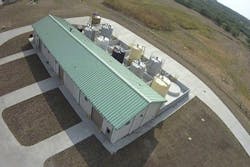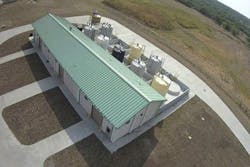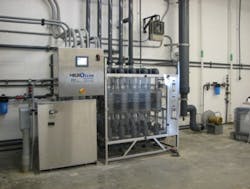Case Study: Texas city expands water treatment plant with disinfection system
May 7, 2014 --
When the city of Midlothian, Texas, was ready to expand their water treatment plant to accommodate a growing population, they carefully considered and investigated their water disinfection options. Accordingly, the MicrOclorTM vertically-arrayed on-site sodium hypochlorite generator from Process Solutions Inc. (PSI) has proven to be a safe and reliable choice for Midlothian residents.
Located south of Dallas and Fort Worth, Midlothian has seen significant growth since plant manager Ben Wilson started with the City of Midlothian Water Treatment Plant in 1991. At that time, the city's treatment plant was relatively new, built in 1987, and was treating an average demand of 1/2 million gallons per day (MGD) with a maximum capacity of 3 MGD. Today, after careful planning for the future, Midlothian's combined water treatment plants average 6 to 8 MGD with a capacity of 18 MGD.
Around 2003, city leaders began anticipating the long-term water treatment needs of Midlothian, Texas, and by 2008, they had begun rigorous planning to accommodate the city's growth, either by building a new plant or expanding the existing facility. Building an additional plant made financial sense, created redundancy and offered the security of being able to survive a weather emergency with minimal disruption to the community.
The original plant uses conventional dual media filtration, sedimentation and gas chlorination. Midlothian initially considered duplicating the treatment technologies for the new plant to simplify operator cross-training. However, they ultimately decided that the best strategy to accommodate long-term future growth was a new membrane filtration system with a chlorine disinfection system.
Because the new plant would be built in a field adjacent to a subdivision filled with families, Midlothian preferred sodium hypochlorite (bleach) as a safer water disinfection alternative to traditional chlorine gas, which has the potential for a chlorine leak. All chlorine compounds are derived from salt, and electrolytic conversion at the facility can result in significant savings, typically costing 50 to 70 percent less to produce sodium hypochlorite on site than to buy pre-made sodium hypochlorite that requires transportation to the treatment plant. In addition, MicrOclor's dilute (0.8 percent) hypochlorite solution is below the hazardous material concentration threshold of 1 percent.
Once Midlothian decided that on-site generation was their best disinfection option, they needed to determine which on-site generation company offered the best product for their needs. Before deciding on the MicrOclor product, they visited multiple facilities that were using different on-site generation technologies.
"We found something common at every location we visited before we saw a MicrOclor unit ... in the time of even a brief site visit, the horizontal-designed on-site generation systems were shutting down two to three times in just a few hours," said Midlothian plant manager Ben Wilson. "The operators didn't seem concerned, explaining that hydrogen gas naturally built up in the system. It wasn't a big deal to fix it, but my team and I didn’t like the idea of a system that required such constant attention."
Then they visited a PSI installation in Pine Bluff, Ark., where a MicrOclor on-site hypochlorite generation system had been installed. There, Wilson and his team talked to the operator and MicrOclor representatives for two hours. Unlike their other site visits, the PSI system didn't shut down a single time. Why? The electrolytic cells -- the heart of the system -- are configured in a vertical format with a recirculation loop on each cell that allows for optimized brine utilization and passive release of the hydrogen gas from each cell. Additionally, removing the hydrogen immediately from each cell eliminates the blinding of the electrodes by the gas bubbles.
After observing the vertical MicrOclor system in Pine Bluff, Midlothian moved ahead to include a 1,200 lbs/day system in the design of the new plant. Installation was successful, with the general contractor preparing the piping and electric and setting and plumbing the unit. PSI's technicians tested and commissioned the system and the new plant went live in July 2013. Wilson reported that the MicrOclor system has exceeded his expectations, and the exceptional customer support from the PSI team has made this project a success. Further, as the area surrounding the original plant continues to develop, the city of Midlothian, Texas, is considering upgrading their existing chlorine gas systems to MicrOclor on-site generation systems.
See also:
"Texas water district to install large capacity hypochlorite generators"
"New Standards May Target Contaminants From Sodium Hypochlorite"
About PSI
Process Solutions Inc. retains on a full-time basis of nine individuals who jointly possess over 300 years of combined experience selling, designing, manufacturing, installing, and servicing similar onsite hypochlorite generation equipment and tank mixing equipment. Together this team has been involved with the successful installation many hypochlorite generation systems and Tank Shark systems. For more information, visit www.4psi.net.
###


